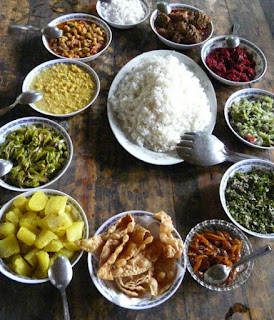On Sunday 23rd October, we started a health care education programme for the people in our village. We engaged Dr. Hasindu Jayatunga as our teacher. He taught us about non-communicable diseases (NCD, also named non-infectious or non-transmissible), such as heart diseases, stroke, cancers, diabetes, chronic kidney disease, osteoporosis, Alzheimer's disease, cataracts, and others. NCDs are the leading cause of death globally.
There is plenty of evidence that a person's lifestyle and environment increases the likelihood of certain NCDs. The WHO's World Health Report 2002 identified five important risk factors for non-communicable disease in the top ten leading risks to health. These are raised blood pressure, raised cholesterol, tobacco use, alcohol consumption, and overweight.
Our second class will be held in the village of Wæwala. The theme of tomorrow in Wewala will be our traditional food style and nutrition.
We like to mention a recent scientific study to our blog readers. It is from the villages of Sinharaja, our famous rainforest in Southern Sri Lanka (Ali & Kumara 2013). In that area, people grow old. The total population of the study area was 864, of which 80 were elderly people above 60 years. The age of the elderly people ranged from 60 to 99 years. The oldest living person was 99 years. All the elderly persons in the sample had good health and sharp memory. The elderly population had been engaged in chena cultivation (slash-and-burn farming), collecting forest material, cutting kitul flowers and hunting. 39 % have been engaged in chena cultivation and 31 % directly in collecting forest materials. All occupations show that they have been closely associated with the forest environment.
50 % of their medicine was collected from the forest, 31 % from their garden and 16 % from their own village indicating about 90 % directly from their own surroundings. Also, the type of food consumed by the elderly people, comprised of a balanced diet which includes fruits, vegetables, green leaves, yams, cereals and others, which are free from modern day agro chemicals. It also shows
their indigenous knowledge of the forest food consumed and the sharpness of their memory by remembering over 100 forest food items, most of which are gathered from the forest. They also consumed some meats and fish.
74 % of them had actively participated in religious activities. The serenity of their minds achieved by participating actively in religious activities may also have contributed to long life. 78 % of the elderly people had indulged in various leisurely activities. The activities mentioned were weaving, spending time with family members, visiting friends and relations, going to the
nearby boutique and reading Jathaka stories after work. Balancing their time with work and leisure indicates a healthy lifestyle that may have contributed towards high life expectancy.
From our health care class. Dr H. Jayatunga in front.
|
References:





No comments:
Post a Comment